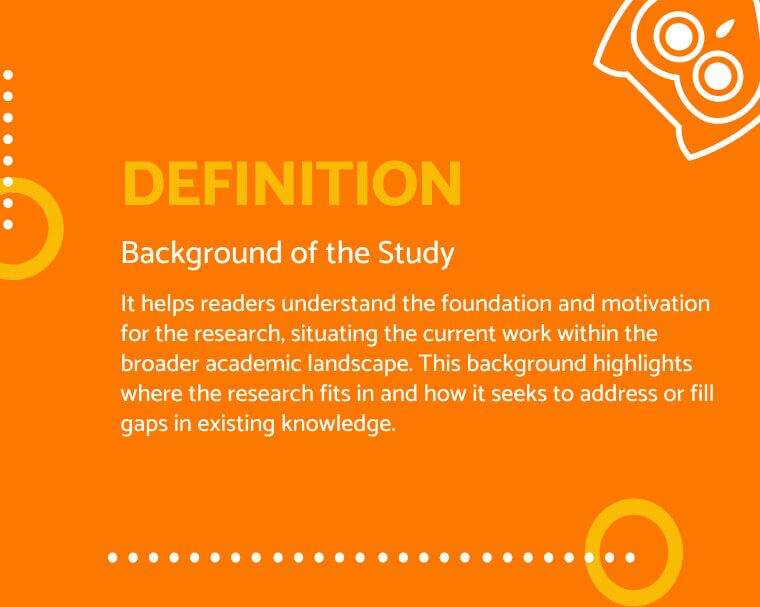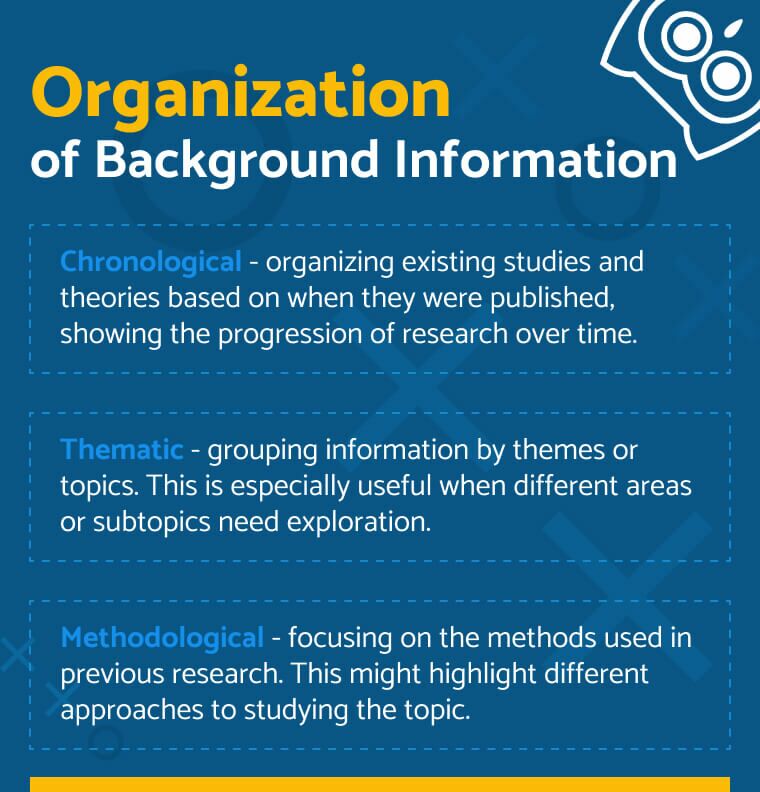Mastering the Basics of Writing Background of the Study
Table of contents
- 1 Purpose of the Research Paper Background
- 2 How to Write a Background of the Study
- 2.1 Starting with Preliminary Research for Broad Context
- 2.2 Organize the Information
- 2.3 Link to Your Research Question
- 2.4 Avoid Plagiarism and Ensuring Proper Citation
- 2.5 Using Clear, Academic Language
- 2.6 Don’t Overload with Excessive Details
- 2.7 Review Relevant Literature
- 2.8 Identify Gaps or Contradiction
- 2.9 Keep Your Target Audience in Mind
- 2.10 Stay Objective
- 2.11 Mention Methodologies, Scope, and Limitations
- 3 Bottom Line
- 4 FAQ
Writing a research paper can be a juggling act, especially for those with little experience. There are so many elements to consider, and you need to cover all the bases if you want your paper to elevate your academic standings.
The background in research paper is where you lay out the topic, the gaps in the literature that this study seeks to fill, and your study’s general and unique contributions. Thus, developing the research paper background section is crucial to give a general overview of the study.
That’s why we’ve decided to give you some pointers, including:
- The purpose of the background of the study;
- Collecting and organizing background information;
- Linking the background to your present study;
- Using proper citation and wording, retaining objectivity.
Purpose of the Research Paper Background

When you write a research background of the study, you explain the rationale and foundation for doing the research. It’s quite different from the research paper introduction section or a literature review. Here, you explore the history, nature, and scope of your research problem. Once you determine how previous studies have covered the problem, you can pinpoint the remaining gaps, discuss their importance, and how your study can fill them.
Essentially, it’s the foundation of your entire study. It determines the structure of your paper, highlights a well-defined research problem, and helps the reader determine your research’s unique and general contributions. Besides serving as a clear roadmap, a well-written background of the study must help the reader understand the value and purpose of your research.
How to Write a Background of the Study
Any researcher needs to understand the steps that go into writing an effective background of the study. Since you don’t have clarity in the early stages, you need to collect more information via preliminary research. Then, you should organize your information in a structure that can seamlessly lead up to your research paper in a way that shows the significance of your study.
So, if you’re wondering what is background of the study in research and how to compose it, here are some tips.
Starting with Preliminary Research for Broad Context
Before delving into writing the background of a research paper, you need a comprehensive review of the most important articles and reports on the subject in a literature review to acquire some introductory background information. Basically, you need to collect as much research data as possible.
To start with the background of an article, look for prior studies that address your issue statement in detail. Refer to reputable resources, such as academic databases and publications, and use their bibliography and literature review section to find new sources. This lets you discover new authors treating your research topic.
Finally, keep note of each piece of material you find if you decide to include it in your thesis. It helps you avoid or at least reduce plagiarism in research when you integrate those sources into your work.
Organize the Information

Now it’s time to discuss a vital writing tip: background information categorization. Most researchers use one of the three approaches: chronological, thematic, or methodological.
Chronological
Here, the study background and contextual information are organized in a chronological structure. As such, the reader can understand how you arrived at your conclusions about the development and the next steps you want to take in your research.
It can also be based on a trend. This method should be used only if you’re sure that the trends build logically upon one another and trace back in time. Overall, you must:
- Highlight only the most crucial background information in research
- Only use facts that can be objectively confirmed
- Find gaps in previous studies
- Give your opinion
Thematical
When the background of a research paper is thematic, it is structured around the topics comprising your research problem. Start by identifying the main and secondary themes. Then, create hierarchies based on their importance or how they’re related to each other.
In other words, it requires structuring the basic background information into paragraphs that highlight themes and identify patterns in the research topic.
Separate each paragraph with a topic sentence, and ensure that each sentence effectively synthesizes background information from many sources. You can also use the famous inverted pyramid method to go from a general overview to the specifics. Overall, this method gives an overview of all topics and themes of your research subject.
Methodological
This approach for writing background of study in research focuses on the methodology in research paper rather than specific topics or the chronological order. It draws attention to the differences and similarities across research methods and offers alternative insights into the subject.
If you cover a topic where there are many relevant models or theories, it is helpful to highlight the most popular ones. In this manner, you can get a basic understanding of the most common perspectives on your subject by categorizing the paper according to the theoretical framework.
Link to Your Research Question
Be specific about the knowledge gap your research study intends to fill and show how this inspired your research questions or theories. This will help place your study in the context of the larger academic discussion while also highlighting its unique contribution.
Avoid talking about irrelevant topics, and focus on what is most important regarding your subject. In other words, every step or theme you discuss should disclose the problems and explain why you deem it important to solve them.
Avoid Plagiarism and Ensuring Proper Citation
Plagiarism is one of the main reasons for writers to seek professional help with research paper writing. To avoid accusations of plagiarism, it is important to properly credit the ideas, models, and conclusions of others. Accurately citing your sources helps maintain academic honesty and gives readers easy access to further basic research papers. When citation or source management becomes overwhelmingly complex, reliable research paper assistance can be invaluable.
The citation style you use may be determined by the guidelines of the publication or the institution you’re affiliated with. There are plenty of online resources, including guidelines and generators, that help you adhere to the given requirements.
Using Clear, Academic Language

An effective background should clearly highlight the research problem and how you plan to address it. This can only be achieved by using the correct terminology while keeping the text clear and understandable. Thus, use technical phrases with caution and provide essential context and definitions for any unfamiliar term.
Make sure that even readers who aren’t familiar with your field can understand the rationale and hypothesis in study papers. Your study will be more accessible and appealing if you do this.
Don’t Overload with Excessive Details
Keep your writing simple and to the point. Although providing sufficient background information helps simplify your study, you should avoid using too many words. Going too deeply into the evidence that inspired your research problem might just confuse your readers.
In other words, it is not necessary to describe every step or every point of relevant research studies. In the background section, only discuss the important details and results that led you to formulate your research question.
Review Relevant Literature
Only by knowing and understanding what has been said and discovered before you can hope to give your contribution. When reviewing relevant research literature, you should provide a concise summary of previous studies and other works that have laid the groundwork for your own. Ensuring the material you use comes from credible sources in research is key. Also, remember to explore all nuances that could help with your research topic.
Identify Gaps or Contradiction
Normally, research objectives are based on the gaps and contradictions found in analyzing the literature review and previous research. Failing to do so might create a redundant or meaningless paper. That’s why, in the background section, you must clarify the reasoning behind how you unveiled the problems you seek to solve. You should also detail the methods to test and quantify your study hypothesis and how your findings will add to what’s already known.
Note that you’re also likely to leave a research gap or have some contradictions in your study. Don’t forget to recognize and inform your readers about them. It shows professionalism and enhances your credibility.
Keep Your Target Audience in Mind
It’s crucial to tailor the background of the study to your audience. Whether for an assignment or an academic publishing, you must write in a way that makes your message come across. So, if you know that the paper is going to be read by experts in the field, it’s ok to use a more technical and complex vocabulary.
Conversely, if the audience is more general, consider their scholarly background, avoid jargon, provide contextual information and explain concepts in a simple way.
Stay Objective
Retaining objectivity is one of the defining key components for all academic essay writer. However, having a personal interest or predisposition for a certain point of view might make it difficult to avoid bias and retain impartiality. Using a wide range of sources that address various topics, viewpoints, and research methods is crucial for maintaining objectivity both in the background and literature review section.
Mention Methodologies, Scope, and Limitations
Scientific research demands appropriate and proven methodologies. That’s why it’s important to clarify which ones you used, why and how they fit in the context of your research. The explanation should include the methodology for data collection and analysis, models, and the tools used.
The reasoning must be linked with the scope of your research. This must be clearly stated and intertwined with methods and context.
Finally, identify and discuss the shortcomings of your study background. It demonstrates that you’ve given careful thought to the study’s limits and have a firm grasp of the subject at hand. Researchers and reviewers will respect you more if you are upfront about the limits of your research methodology and go into depth about them rather than pretending they don’t exist.
Bottom Line
The first stage in writing a great research paper is to provide an intriguing background for the study. Its purpose is to explain the bigger picture, stress the importance of your study, and lay out the key issues you chose to study. Don’t forget that the background section of research paper writing isn’t a literature review. It discusses the reasons behind your study, points out any gaps in existing works, and explains how you would help fill those gaps.
All this should have taught you how to write a background for a research paper. But don’t forget that knowing the theory is only the first step. Whenever you feel stuck, don’t be shy to ask for guidance and rely on the help of experts.







